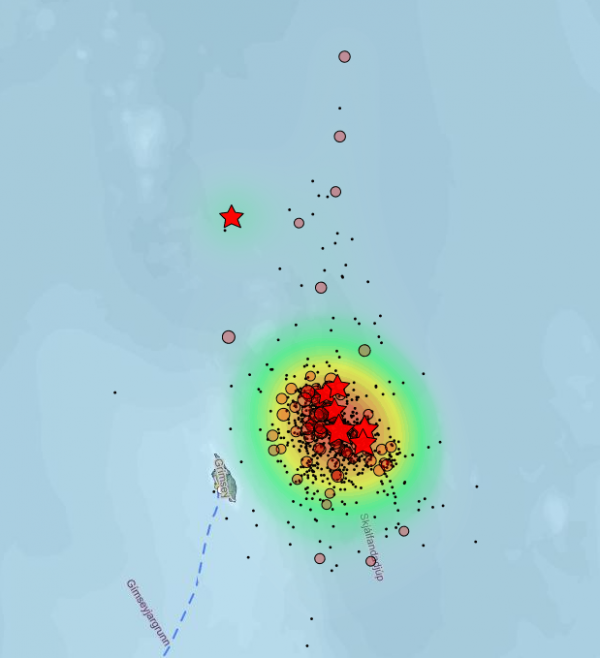The intense earthquake swarm which has been Grímsey island, the northernmost settlement of Iceland, shows no sign of dying down. The Seismic Monitoring System of the Icelandic Meteorological Office has recorded more than 1,200 tremors in the past 48 hours, including nearly a dozen quakes larger than 3 on the Richter scale.
Swarm shows no sign of slowing down

The swarm began on Wednesday and shows no sign of slowing down. Quite the contrary, as it seems to be intensifying rather than slowing down. The frequency of larger quakes has increased.
Read more: Iceland's northernmost point trembles: Hundreds of tremors in submarine rift valley in past 48 h
The earthquake swarm is unusual both for its intensity and length. Grímsey island is located in an area known for high levels of seismic activity, but under normal circumstances earthquake swarms tend to pass over, and include at most a handful of more powerful quakes. Continuous swarms with numerous larger quakes are less common and could be associated with something bigger. The island has seen repeated waves of earthquake swarms since late January.
A number of large quakes
The largest quake in the current swarm was a 4.1 magnitude quake early yesterday evening at 19:37. This quake was accompanied by two other 3+ quakes. Three more relatively powerful quakes were recorded over night, and at 7:50 a wave of three more powerful quakes were recorded, two 3.6 magnitude quakes and a third 3.5 magnitude quake.

Read more: Why the constant earthquakes? Iceland is slowly being torn apart
The quakes have been felt very clearly by the inhabitants of the island. According to residents any quake larger than 2.5 can be felt very clearly. The island has experienced nearly 200 separate quakes larger than 2 in the past 48 hours. The epicenter of the activity has been in an submarine drift valley 10 km (6.2 mi) northeast of Grímsey at a depth of 10-24 km (6.2-15 mi).
A seismologist with the Icelandic Meteorological Office told the local newspaper Morgunblaðið that the there are a number of known rifts in the area where the earth's crust is pulled apart by the movement of the tectonic plates. The movement of the plates creates energy which is then released in earthquake swarms.

The intense earthquake swarm which has been Grímsey island, the northernmost settlement of Iceland, shows no sign of dying down. The Seismic Monitoring System of the Icelandic Meteorological Office has recorded more than 1,200 tremors in the past 48 hours, including nearly a dozen quakes larger than 3 on the Richter scale.
Swarm shows no sign of slowing down

The swarm began on Wednesday and shows no sign of slowing down. Quite the contrary, as it seems to be intensifying rather than slowing down. The frequency of larger quakes has increased.
Read more: Iceland's northernmost point trembles: Hundreds of tremors in submarine rift valley in past 48 h
The earthquake swarm is unusual both for its intensity and length. Grímsey island is located in an area known for high levels of seismic activity, but under normal circumstances earthquake swarms tend to pass over, and include at most a handful of more powerful quakes. Continuous swarms with numerous larger quakes are less common and could be associated with something bigger. The island has seen repeated waves of earthquake swarms since late January.
A number of large quakes
The largest quake in the current swarm was a 4.1 magnitude quake early yesterday evening at 19:37. This quake was accompanied by two other 3+ quakes. Three more relatively powerful quakes were recorded over night, and at 7:50 a wave of three more powerful quakes were recorded, two 3.6 magnitude quakes and a third 3.5 magnitude quake.

Read more: Why the constant earthquakes? Iceland is slowly being torn apart
The quakes have been felt very clearly by the inhabitants of the island. According to residents any quake larger than 2.5 can be felt very clearly. The island has experienced nearly 200 separate quakes larger than 2 in the past 48 hours. The epicenter of the activity has been in an submarine drift valley 10 km (6.2 mi) northeast of Grímsey at a depth of 10-24 km (6.2-15 mi).
A seismologist with the Icelandic Meteorological Office told the local newspaper Morgunblaðið that the there are a number of known rifts in the area where the earth's crust is pulled apart by the movement of the tectonic plates. The movement of the plates creates energy which is then released in earthquake swarms.








